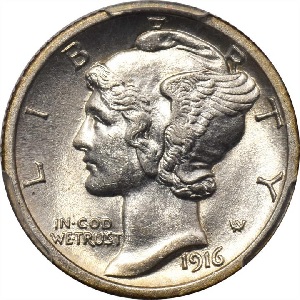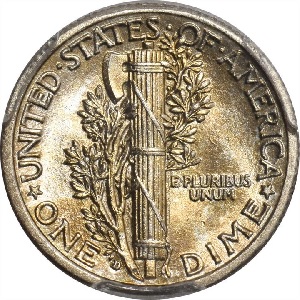1916-D Mercury Dime
The Liberty Head dime of Adolph A. Weinman, more commonly called the Mercury dime, made its debut in 1916 to rave reviews. Weinman intended to portray Lady Liberty wearing a winged cap symbolizing freedom of thought, but the public mistook her for the fleet-footed Roman messenger god Mercury. Although technically not correct, the “Mercury” moniker stuck like glue to the coin and remains in common use to this day.(1)
The Philadelphia and San Francisco Mints cranked up their coining presses in 1916 to strike 22.18 million and 10.45 million of the new dime, respectively.(2)
The Denver Mint, however, was marching to a different tune, with their priorities focused on production of the outgoing Barber quarter (the dies for the new Standing Liberty quarter were not ready).
Somehow, they found time to strike a tiny mintage of 264,000 Mercury dimes. More 1916-D dimes might have been issued had it not been for an emergency order from the Treasury Department on November 24 for another four million quarters. All other coining activity at Denver was halted to divert the resources necessary to comply with the mandate from Washington.(3)
For many years, the 1916-D dime circulated without drawing the attention of collectors. We know this because the majority of surviving examples today display heavy wear.(4)
The relative scarcity of the 1916-D dime was not widely appreciated until the advent of coin boards in the mid-1930s. Because most Mercury dime boards had an empty slot where the 1916-D was supposed to go, the coin became one of the hottest topics of conversation in the collecting community.(5)
The final year for the Mercury dime was 1945, replaced by the familiar Roosevelt dime the following year. The 1916-D is the only date with a regular issue mintage under one million, underscoring it as the kingpin key date of the entire series.
Be careful! There are many alterations out there, where a "D" mint mark was surreptitiously affixed to a common 1916 dime from the Philadelphia Mint (which of course, had no mint mark). Other methods of trickery have been tried as well. PCGS stated they receive 5-10 fakes weekly.(6)
Despite being one of the most famous rarities of the 20th century, price movements for the 1916-D Mercury dime have been uncharacteristically slow for years. The numismatic fundamentals supporting this key date remain in place, so it is logical to expect this coin at some point to again run as swiftly as its namesake.
| Estimated survivors in all grades: 10,000 ?
The survivor estimate from PCGS represents an average of one or more experts' opinions as to how many examples survive of a particular coin in all grades. Survival estimates include coins that are raw, certified by PCGS, and certified by other grading services. Learn more at PCGS. |
| PCGS Rarity Scale: 3.0 ?
The 'PCGS CoinFacts Rarity Scale' assesses the relative rarity of all U.S. coins, based on estimated surviving examples. The scale runs from 1.0 to 10.0. The higher the number, the rarer the coin.
Learn more at PCGS. |
| Click HERE to check for availability on eBay** |
Preview of eBay selection:
 |
 |
| Trendline Avg = 7.04 | CLASSIC RARITY |
Historic Value Trend Charts:
| Last updated 3-5-25 | Return to Key Date Coin List | |
| Compare to Common Date Coin of Same Type | ||
|
|
||
| Download Charts to Your Computer | ||
Sources
1. Garrett, Jeff and Guth, Ron. 100 Greatest U.S. Coins, 5th ed. Pelham, AL: Whitman Publishing, 2019.
2. Stack's Bowers Galleries. 1916-D Mercury Dime. Mar 2020 Auction.
3. Stack's Bowers Galleries. 1916-D Mercury Dime. Jun 2017 Auction.
4. Stack's Bowers Galleries. 1916-D Mercury Dime. Mar 2020 Auction.
5. Heritage Auctions. 1916-D 10C. Nov 2013 Auction.
6. PCGS. 1916-D 10C (Regular Strike).
**Many very fine coin dealers sell on eBay. At any point in time, there may be over one million search results for United States coins. This includes quite a few of the recommendations on our Key Date Coin List.
If you’re thinking about purchasing a rare coin, eBay is certainly worth a look. For your convenience, the links from this site to eBay are coded to bring up only coins certified by PCGS and NGC.
As is always, always the case, never buy a valuable coin from a seller whose trustworthiness cannot be verified. Learn more about this at our chapter Best Places to Buy Coins, which also has a section on doing business on eBay.
In the interest of full disclosure, Rare Coins 101 receives a small commission anytime someone connects to eBay from this site and purchases something.
Coin images by Stack's Bowers Galleries.


